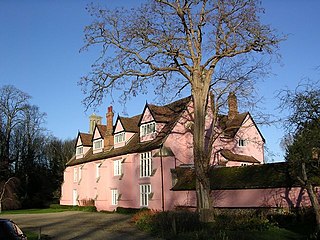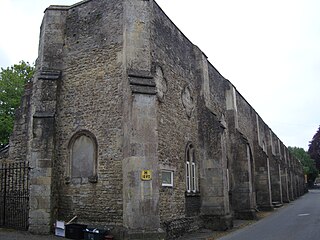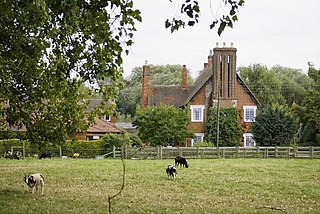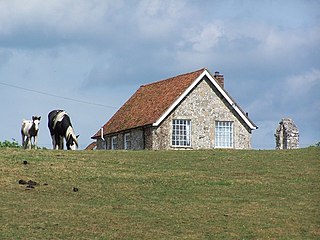
Thetford Priory is a Cluniac monastic house in Thetford, Norfolk, England. It should not be confused with the Dominican Friary of Blackfriars, Thetford that later became part of Thetford Grammar School.

Weybourne is a village on the coast of North Norfolk, England. The village is surrounded by arable fields, woodland, and heathland and straddles the A149 coast road, three miles west of Sheringham, within the Norfolk Coast AONB. The area is popular for the local countryside and coast and in particular for walking, wildlife, and bird-watching.

Clare Priory is a religious house in England, established in 1248. It is situated on the banks of the River Stour, Suffolk, a short distance away from the medieval village of Clare. It was the first house of the Augustinian Friars in England. The house passed through many hands until it was again purchased by the Augustinian friars in 1953. Today the Priory offers modern retreat facilities for guests.

Bruton Abbey in Bruton, Somerset was founded as a house of Augustinian canons in about 1127, and became an abbey in 1511, shortly before its dissolution in 1539. It was endowed with manors, churches and other properties in the area and also in Normandy in France.
Haltemprice Priory was an Augustinian monastery approximately two miles south of the village of Cottingham in the East Riding of Yorkshire, England. The original monastic buildings have long since gone, although ruins of a farmhouse, built in 1584, remain on site and incorporate some of the Priory stonework.

Newark Priory is a ruined priory on an island surrounded by the River Wey and its former leat near the boundary of the village of Ripley and Pyrford in Surrey, England.

The Priory of St Mary in the Meadow, also known as Beeston Priory is a former Augustinian Priory, located in the village of Beeston Regis, Norfolk, United Kingdom.

St Osyth's Abbey was a house of Augustinian canons in the parish of St Osyth in Essex, England in use from the 12th to 16th centuries. Founded by Richard de Belmeis, Bishop of London, c. 1121, it became one of the largest religious houses in Essex. It was dedicated to Saints Peter and Paul as well as St Osyth (Osith), a royal saint and virgin martyr. Bishop Richard obtained the arm bone of St Osyth from Aylesbury for the monastic church and granted the canons the parish church of St Osyth.

Flanesford Priory was an Augustinian priory in Herefordshire, England.

Bilsington Priory is a former Augustinian priory in Kent, England, about 3⁄4 mile (1 km) north of Bilsington and about 5 miles (8 km) south of Ashford. It was founded in 1253 by John Maunsell, with help from the canons of Merton Priory, which provided the first three priors. Being a monastic house under £200, it was suppressed in the 1536 Dissolution of the Monasteries. Its lands were granted to Anthony St Leger, who exchanged them with Thomas Cranmer, Archbishop of Canterbury.

Kirby Bellars Priory was a small priory of Canons Regular of Saint Augustine in Leicestershire, England. It is now the Church of England Parish Church of Saint Peter's serving the village of Kirby Bellars.

Coxford Priory or Broomsthorpe Priory was a monastic house in Norfolk, England.
Hickling Priory was an Augustinian priory located in Norfolk, England.

Pentney Priory was an Augustinian priory at Pentney in the district of King's Lynn and West Norfolk, Norfolk, England. The ruins of the priory, mostly comprising the flint-built gatehouse, are Grade I listed.

Holy Sepulchre Church, Thetford was a medieval monastic house in Thetford, Norfolk. The ruined nave of this 14th-century church are the only surviving remains in England of a priory of Canons of the Holy Sepulchre, who followed the Rule of Saint Augustine and aided pilgrims to Christ's tomb. It was later used as a barn, and is a Grade I listed building.

West Acre Priory of St. Mary and All Saints was a medieval monastic house at West Acre in the King's Lynn and West Norfolk district of Norfolk, England founded c.1100 by the de Toni family. Later an Augustinian fraternity, it was closed down in 1538 as part of the Dissolution of the Monasteries under King Henry VIII. It is now a ruin with no intention of being repaired.

Studley Priory, Warwickshire, was a priory in Studley, Warwickshire, England.

Ivychurch Priory was a medieval monastic house in Alderbury, southeast of Salisbury, Wiltshire, England. According to Historic England, "all that remains is a cylindrical pier with multi-scalloped capital and part of the double-chamfered arch with a respond to the west with a half-pier and capital; this is attached to the west wall of the church which retains one buttress".

















